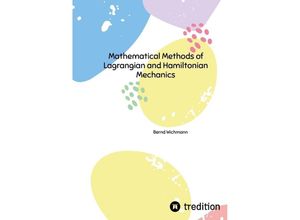This book is intended to help students of physics and other branches of science in the first
semesters of their studies to better understand the applied mathematical methods of Lagrangian
and Hamiltonian mechanics. The book has the benefit of learning in addition to the physical
processes of classical mechanics with focus on Lagrangian and Hamiltonian mechanics the
mathematical methods that are equally needed in other branches of physics. These include:
Vector calculus matrix calculus tensor calculus differential equations derivative chain
rule Taylor series differential geometry implicit function theorem coordinate
transformation (Jacobian) curvilinear coordinates Legendre transformation and much
more.Chapter 1 describes the basics of Newtonian mechanics in a review. In addition to Newton's
laws the two-body problem is dealt with in detail. Kepler's laws are a by-product of
this.Chapter 2 explains the origins of the variation technique with its historical origin in
the brachistochrone problem. After introducing generalised coordinates and applying Newton's
principle of determinacy the Lagrangian approachfor mechanical systems is derived. The
conservation laws play an important role in this context. Applications are shown for motions in
a central field. The Lagrangian dynamics for oscillations with the various modes is discussed
in depth. The application of linear algebra (eigenvectors normal coordinates) is treated in
great detail.Chapter 3 develops the Hamiltonian dynamics for mechanical systems. The transition
from the configuration space of Lagrangian mechanics to the symplectic phase space of
Hamiltonian mechanics (Legendre transformation) isdiscussed. An additional section deals with
Routh's procedure which can be described as a mixture of Lagrangian and Hamiltonian
mechanics.The extension of the permissible transformations of the variables of Hamiltonian
mechanics in comparison to Lagrangian approach leads us to the canonical transformations
Chapter 4. Here the generating functions of the canonical transformations are derived with the
help of the Legendre transformation. The symplectic relationship of canonical transformations
is clearly worked out.In Chapter 5 the Hamiltonian equations of motion are described using the
Poisson formalism which provides the equations of motion with a symmetrical form. Further
topics such as constants of motion Jacobi identity canonicalinvariance Liouville's theorem
etc. are treated in detail.Hamilton-Jacobi theory Chapter 6 considers the interesting
approach of finding a canonical transformation in which the phase space coordinates and the new
Hamiltonian are all constant. This is discussed in depth and the student is given a procedure
for solving a mechanical system.A canonical transformation the so-called action-angle variable
which is discussed in Chapter 7 is suitable for periodic phase orbits. The important field of
adiabatic invariants with reference to quantum mechanics is also discussed.The texts are
supported with many graphics and help the student to grasp the current topic more intuitively.
All chapters contain many exercises. The student is encouraged to first try to solve the
exercises independently before consulting the solutions provided.

